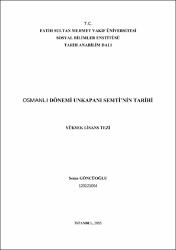| dc.contributor.advisor | Özcan, Abdülkadir | |
| dc.contributor.author | Göncüoğlu, Sema | |
| dc.date.accessioned | 2015-11-12T14:21:46Z | |
| dc.date.available | 2015-11-12T14:21:46Z | |
| dc.date.issued | 2015 | |
| dc.date.submitted | 2015 | |
| dc.identifier.citation | GÖNCÜOĞLU, Sema, Osmanlı Dönemi Unkapanı Semti’nin Tarihi, Fatih Sultan Mehmet Vakıf Üniversitesi Sosyal Bilimler Enstitüsü Tarih Anabilim Dalı, Yayımlanmamış Yüksek Lisans Tezi, İstanbul 2015 | en_US |
| dc.identifier.uri | https://hdl.handle.net/11352/2251 | |
| dc.description.abstract | Miladi 600, 1200, 1500, 1600 ve 1700 yıllarında dünyanın en kalabalık şehri olarak öne çıkan İstanbul, 1453 yılı sonrası Osmanlı başkenti olmasıyla beraber yaklaşık 250 yıl boyunca dünyanın en kalabalık şehri olma vasfını sürdürmüştür. Böyle kadim bir şehrin gıda sorununu ise, büyük bir organizasyonla çözerken, Akdeniz dünyasının tahıl ihtiyacını da karşılayan bir üst olma vasfını da korumuştur.
İşte bütün bu iktisadi ve sosyal organizasyonun İstanbul içerisinde yönetim merkezi, devasa Haliç limanı arasında Unkapanı Semti’nde teşekkül ettirilmişti.
Bu tez çalışmamızın, birinci bölümünde, böyle bir teşekkülün oluşmasındaki coğrafi şartların oluşumunun ardından Unkapanı Semti’nin İstanbul Şehri içerisindeki sınırları ve tarihi gelişimi belirtilmiş olup, devamı bölümlerde sırasıyla semtin tarihi mirası olan, cami-mescid yapıları, tekke ve sinagog binaları ile çeşme, sebil, hamam ve hazireleri ile ayazması incelenmiştir. Ve günümüze ulaşmamış, yeni imar yolların açılması sırasında yıktırılan veya afetler sebebiyle günümüze ulaşmamış eserler de arşiv fotoğraflarıyla belgelenmeye çalışılmıştır.
Tez akışı içerisinde kamu yapıları olan, karakol binası, köprü, değirmen binası, askeri fırın gibi yapılar da bu incelemeler içerisinde ortaya konulmuştur.
Bu tez çalışmasında amacı, Unkapanı Semti’nin monografyasının ortaya çıkarılmaya çalışılması olup, semtin dünü ve bugünü ile yaşadığı fiziki ve sosyal değişim de ortaya konulmaya çalışılmıştır. | en_US |
| dc.description.abstract | Istanbul, which is known as the most populous city in the World in 6th, 12th,15th, 16th and 17th century A.C. continued its character approximately 250 years forbeing the capital of Ottoman Empire after 1453. The problem of nutrition such a huge city was being solved with a huge organization and it was also protected to be the first in supplying the needs of grains of Mediterranean.
So, all of these social and economic organizations had been realized in Istanbul at Haliç Port in the quartier of Unkapanı.
In the first chapter of our study it was aimed to demonstrate the formation of geographic conditions of this realization as a result of the description and historical development of Unkapanı in Istanbul, the continuous chapters it was aimed to examine the buildings that was called as historical heritage, like mosque, tekke, synagogue, fountain, Turkish baths and other sacred buildings and structures. It was tried to document the pieces or the creations disappeared with the photos in archives because of the disasters or reconstruction.
In the study, other public buildings such as bridge, police station, mill, military bakery etc. were examined, also.
The aim of this study is to demonstrate the monographic of Unkapanı and its physical and social changes of this quarter. | en_US |
| dc.language.iso | tur | en_US |
| dc.publisher | Fatih Sultan Mehmet Vakıf Üniversitesi, Sosyal Bilimler Enstitüsü | en_US |
| dc.rights | info:eu-repo/semantics/openAccess | en_US |
| dc.subject | İstanbul’un Fethi | en_US |
| dc.subject | Unkapanı Kapısı | en_US |
| dc.subject | Buğday Ticareti | en_US |
| dc.subject | Limanlar | en_US |
| dc.subject | The Conquest of Istanbul | en_US |
| dc.subject | Unkapanı Gate | en_US |
| dc.subject | Wheat Trading | en_US |
| dc.subject | Ports | en_US |
| dc.title | Osmanlı Dönemi Unkapanı Semti’nin Tarihi | en_US |
| dc.type | masterThesis | en_US |
| dc.contributor.department | FSM Vakıf Üniversitesi, Sosyal Bilimler Enstitüsü | en_US |
| dc.relation.publicationcategory | Tez | en_US |
| dc.contributor.institutionauthor | Göncüoğlu, Sema | |



















